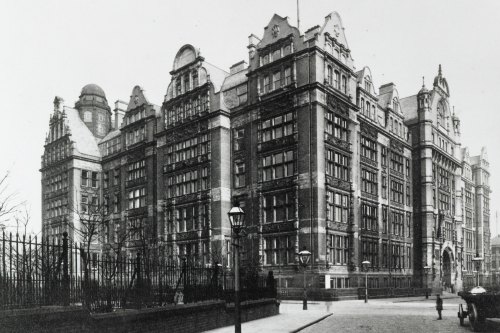The Sackville Street Building
In 1895 construction began on a new building for the growing Manchester Municipal Technical School. Opened in 1902, The Sackville Street Building has been home to the study of science, technology and engineering at Manchester for over 100 years.

By 1883, the Manchester Municipal Technical School had begun to offer day courses covering a range of subjects including mechanical engineering, chemistry, bleaching, dyeing and printing. To cope with the influx of new students and the need for extra workspace, the School decided to commission a new building. The School was awarded the former site of Sir Joseph Whitworth’s engineering works by Whitworth’s legatees along with a grant of £5,000 for the proposed project.
In order to ensure that the design of the new building was cutting-edge and to gain inspiration, School council members visited various technical schools across Europe before deciding to base their new home on the Building Trades School in Stuttgart.
On the advice of architect Alfred Waterhouse, the School Council selected Spalding and Cross of London as the architects for the project. The first sod of earth in construction was turned by Chairman Alderman James Hoy in July 1895, with a silver-plated spade that is still in the University’s possession today.
The Sackville Street Building became a grand structure in the French Renaissance style and boasted the finest Edwardian brickwork and terracotta in the region. It was officially opened in 1902 by Prime Minister Arthur Balfour.
This building is perhaps the greatest of this kind of municipal enterprise in the country … nobody can go over this building, observe its equipment … without feeling the corporation of this great city have set an example worthy of the place they hold in Lancashire – and in Great Britain.
Prime Minister Arthur Balfour / on opening the building in 1902
The Sackville Street Building, along with many other buildings owned by the University, is now classed as Grade II-listed.
The building went on to house the historical Godlee Observatory which sits on the roof of the building. The Observatory is still in use by the Manchester Astronomical Society and forms an important part of the Sackville Street Building’s history.
In 1918 the Manchester Municipal School of Technology became known as the Municipal College of Technology, in recognition of the more advance research undertaken and course on offer. During the Second World War, in the summer of 1940, the building suffered a direct bomb hit – a bomb crashed straight through the South West Corner of the Chemistry Laboratory and exploded in the Senior Common Room. Thanks to its sturdy construction, the Sackville Street Building suffered no lasting damage – shattered windows were replaced and demolished rooms were quickly restored.
Students and staff played an integral role during wartime; the College was used by various ministries and armed forces for technological investigation. During this time various new advances were developed and manufactured within the building in order to aid the war effort, including a deep sea hydrophone to counter the submarine threat to shipping, instruments to measure the permeability of airship fabrics and a high-frequency alternator to power aircraft radios.
In 1927 plans had been drawn up to extend the Sackville Street Building. The construction had started in 1938 but was significantly slowed by the Great Depression and the Second World War; the expansion was finally finished in 1957. The conclusion of the building expansion coincided with the college receiving its own independent University status in 1956 and from 1966 it became known as the University of Manchester Institute of Science and Technology (UMIST). In 2004, UMIST merged with the Victoria University of Manchester and became part of The University of Manchester.
